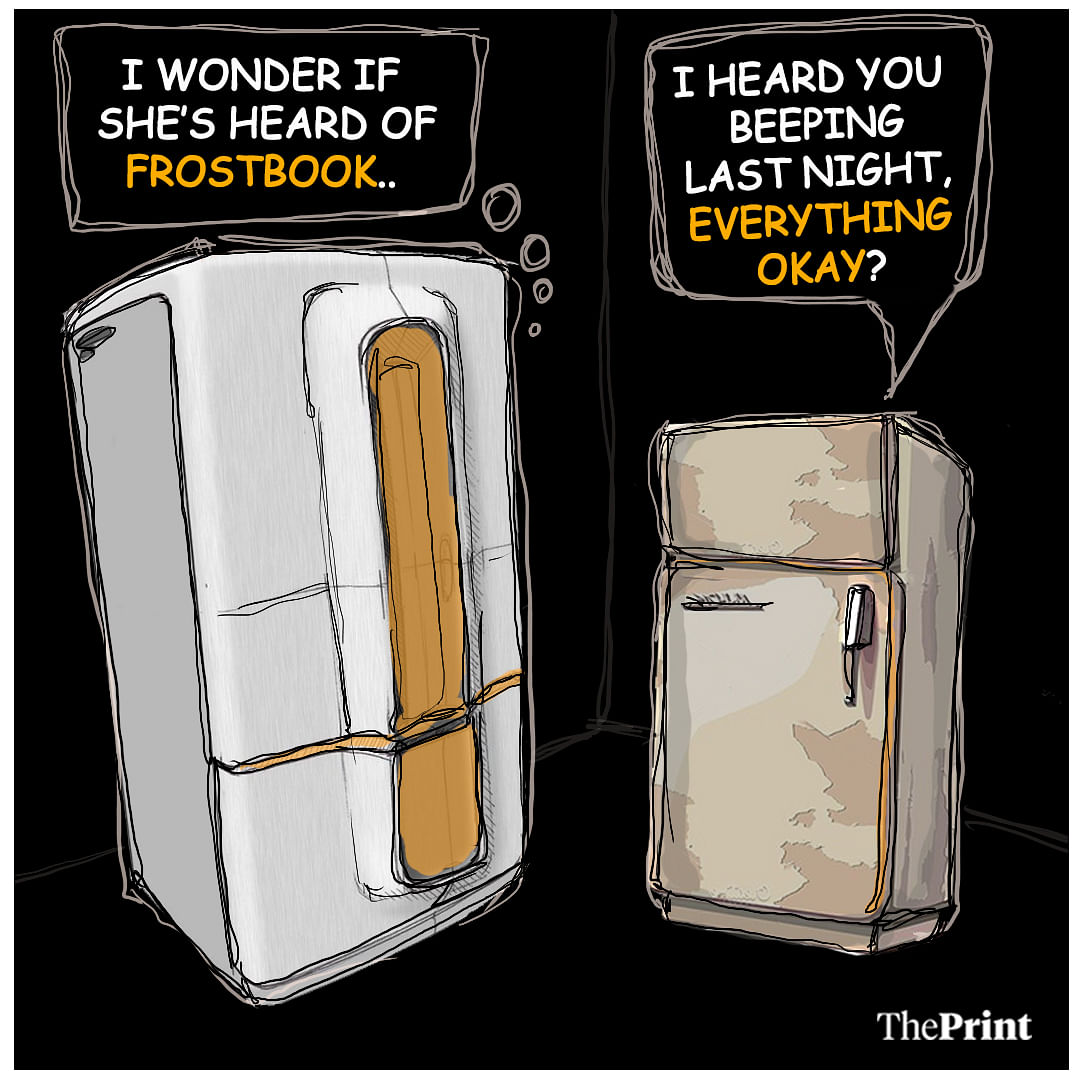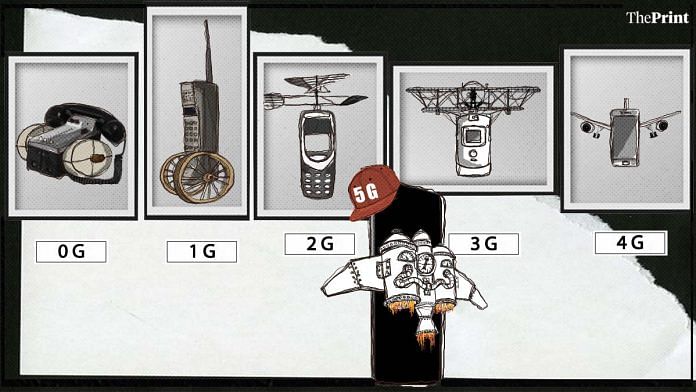New Delhi: It’s internet like we’ve never seen it before — not just fast movie downloads, we’re talking cars that converse with each other to avoid accidents caused by human error, and complicated remote surgery in the remotest areas by doctors based hundreds of kilometres away in big cities.
The next big thing in wireless connectivity, 5G has the world curious: A search on Google throws up 836 million results for “5G”, when “Narendra Modi” draws just 114 million.
And, despite the fact that only “15 per cent of global mobile connections” are expected to be on 5G by 2025, the excitement is easy to understand.
So, here’s everything you need to know about 5G.
What does ‘5G’ mean?
The “G” stands for “generation” and the “5” means it’s fifth in a series. Put the two together, and “5G” means the latest and greatest technological advance in mobile wireless communication — a technology to make mobile wireless communication faster than ever before.
It is expected to irrevocably change human life, much more than its predecessors (1G, 2G, 3G, 4G), which were all landmark innovations at the time of their launch.
Picture this: You will be able to groove to your favourite song on the morning commute without bothering about those maddening potholes because your self-driving car will manoeuvre itself around them 250 times faster than you ever can, using internet speeds 20 times faster than are available right now.
Also Read: Three reasons why it’s not Huawei or the highway for India’s 5G future
Why is 5G so different from 4G?
According to Rajan Mathews, director general of industry body Cellular Operators Association of India (COAI), “the type of traffic, quantum of traffic, type of applications, and the kinds of industries that use our networks have sort of gone up to a different level”.
The 5G network will answer this very need, using a larger chunk of electromagnetic waves to transmit communication than 4G, the current fastest network that came on the market with a promise of quick movie downloads and clear video calls on the go.
So, 5G can accommodate data consumption of not just more smartphones and laptops, it can also allow data consumption by gadgets that never used to be connected to the internet.
As Mathews said, “Now, you have refrigerators talking to something, your cameras talking to something else.”

This bit where gadgets are “talking” and connected to each other via the internet is called ‘Internet of Things’. For example, a sensor in your water metre can alert another sensor when too much water has been used and shut down the supply, increasing resource management efficiency, or a drone can be alerted to shoot down anything in a matter of seconds.
Under this system, data from sensors installed at traffic lights, police stations, public parks can all be accessed in real time, allowing better city management.
Where did 5G come from?
It wasn’t as if Harry Potter waved a wand and, voila, 5G came to be. The technology is the result of years of advances that have incrementally helped humans become more connected even when miles and oceans apart.
Before 5G, there were 0G (zero generation), 1G, 2G, 3G, and 4G.
The technology known as 0G came about in the 1940s, after World War 2, and is also called “pre-cellular mobile telephony technology”, where not-so-mobile telephone systems installed in cars and trucks required assistance of an operator to make or receive calls, just like operator intervention was required to dial landline telephones at the time.
The next generation, 1G, was introduced in the 1980s — this came with the large analog cellphones you would have seen in some of the older sitcoms and movies, and did away with the need to have a human operator connect calls.
In the 1990s, 2G started making telecommunication digital like never before. With 2G, the voice wave generated by a caller was transformed into zeroes and ones and then transmitted via an electromagnetic wave.
Going digital meant more voice calls could be transmitted at the same time. It also meant that anything that could be digitised, like an email or SMS, could also be transmitted on electromagnetic waves.
The next leap, 3G, came in the early 2000s and made it all faster. The current technology, 4G, was launched in late 2009 and is faster still.
It made wireless internet fast enough that you could stream not just a three-minute music video but also a three-hour Karan Johar spectacle without buffering. Companies like Ola, Uber, Airbnb, and Swiggy, primarily providing services via the internet, introduced the world to gig economy and notched up billions of dollars in net worth.
Also Read: Eco-friendly phone companies brace for 5G’s energy bill
Why do we keep making so many ‘generations’?
As Mathews of COAI explained, consumer demand for telecom services is growing and we can’t keep using the bands of electromagnetic waves already in use.
We need to find more to transmit the extra data. Since not all parts of the waves behave the same way, we need to develop or advance existing communication technologies to tap another spectrum of the waves.
By 2019, 5G is already being used in parts of the world.
Who invented 5G?
No one person or organisation invented 5G or its predecessors. These technologies are the result of years of hard work by many scientists, mathematicians, engineers and telecom companies.
In 1979, Japanese telecom company Nippon Telegraph and Telephone set the ball rolling on 1G network.
Martin Cooper at Motorola is behind the first truly portable mobile phone, launched in the market in 1983.
Professor Arogyaswami Paulraj’s work on a technology called MIMO (multiple input, multiple output) to increase data transmission efficiency is one of the main reasons why 4G is fast.
As for 5G, Huawei owns about 15 per cent of related patents.
Oh, and not to forget the men who started it all, Alexander Graham Bell, who invented the telephone, and Guglielmo Marconi, a pioneer in the development of shortwave wireless communication.
Who owns 5G?
No one really owns 5G — or owns all of 5G.
The closest anyone comes to “owning” 5G is to own a patent for some invention that contributed to its existence.
It is even better if these patents are SEP — Standard Essential Patents. Other companies will pay billions of dollars to use an SEP because these have been deemed the most efficient way of doing things.
Analytics firm iPlytics says Huawei has the largest declared SEP portfolio for 5G, followed by Nokia, ZTE, LG and Samsung.
Where does 5G live?
5G lives in Delhi.
That was a joke, obviously — 5G doesn’t exactly exist or live in one place.
You can find 5G on a telecom network. These networks are physically spread out from the core network that processes communications users send each other, to cell towers, to the end user’s phone.
It’s complicated, pointing out where 5G lives, but you can know when 5G is around you — just look for the “5G” sign at the top of your phone screen.
Also Read: Here’s what Modi govt must do when 5G arrives: give spectrum free to Jio, Airtel & others







I don’t know what world you live in but we need cheap basic cars that you can buy for under $2,000 go to simple as possible so you don’t have to take him in the shops to work on them. Nobody needs nor can they afford computerized cars that communicate and drive themselves
Informative article. However, it does not say that for IOT to work, your devices should also be internet enabled as well and that can be far away in time, at least in India for majority of us to benefit fully. The most important take way from the article and for which the author needs to be warmly complimented is, of course, to remind us that “A search on Google throws up 836 million results for “5G”, when “Narendra Modi” draws just 114 million”!!